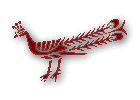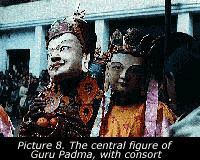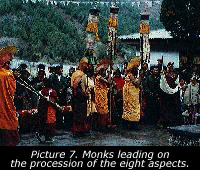 |
|
| ISSN 1084-7553 | |
| IJTS Vol. 1, No. 2 November 1995 |
|
| Editorial Note | |
| The Dance of... | |
| Setting | |
| The Tradition... | |
| The Guru... | |
| The Guru... | |
| The Tenth Day... | |
| The Eight Aspects... | |
| Conclusion... | |
| Computer Space | |
| News | |
| Letters | |
| Support The IJTS |
|
|
|
|
| Search |
|
| Register |
|
| Create Your Profile | |
| Recover Password | |
| Log In |
|
| Institutional Sub |
|
| none | |
| by Cathy Cantwell |
|
 In the middle of the file walked the central form of the Guru flanked by his two consorts, with a monk holding a large ceremonial parasol over his head. The monastery's slob-dpon had requested a local respected sngags-pa (non-monastic mantra practitioner) to act as the Guru, since it is vital that the central figure should be an advanced meditation practitioner who can maintain awareness of himself as the Guru, and he should be felt by observers to embody Guru Padma's presence. In front of the Guru, ZAkya Seng-ge, Padma rGyal-po and Padmasambhava walked in file, and behind, Padma 'Byung- gnas, Blo-ldan mChog-sred and Nyi-ma 'Od-zer. They did one circumambulation of the courtyard while the two wrathful aspects, rDo-rje Gro-lod and Seng-ge sGra-sgrogs, danced, whirling around the courtyard. Then, they seated themselves along one side of the courtyard, the two wrathful aspects completing their dance and taking their places at the two ends of the line. Usually, I was told, ZAntarakSita and Khri-Srong lDe-brtsan would also appear, as the other main figures who made the rNying-ma-pa lineages possible, but they were not represented because of the shortage of monks.33 [This is a preview of the full page; if you are a member of the Asiatica Association and have access to the IJTS, please login using the box on the left menu; non members: please become a member to support the Asiatica Association, and get full access to our publications.] |
|
©1995-2006 Asiatica Association. All Rights Reserved
site development L. Magnocavallo / site comments E. Garzilli |
 The Eight Aspects Dance.
Following an hour and a half's break during which the dancers
could rest and eat, at about 3 pm., the procession to lead on the
Guru and his aspects began.
An older monk who had taken part in the
morning dances led, carrying a white flag topped with burning
incense. Behind, four monks held up "victory banners" (rgyal-
mtshan); these are used in ceremonial processions to mark the coming
of a high lama. They were followed by monks playing long horns and
trumpets, while the monk musicians alongside joined in making music.
Many spectators put the palms of their hands together in respect as
the Guru's aspects emerged from the temple.
The Eight Aspects Dance.
Following an hour and a half's break during which the dancers
could rest and eat, at about 3 pm., the procession to lead on the
Guru and his aspects began.
An older monk who had taken part in the
morning dances led, carrying a white flag topped with burning
incense. Behind, four monks held up "victory banners" (rgyal-
mtshan); these are used in ceremonial processions to mark the coming
of a high lama. They were followed by monks playing long horns and
trumpets, while the monk musicians alongside joined in making music.
Many spectators put the palms of their hands together in respect as
the Guru's aspects emerged from the temple.